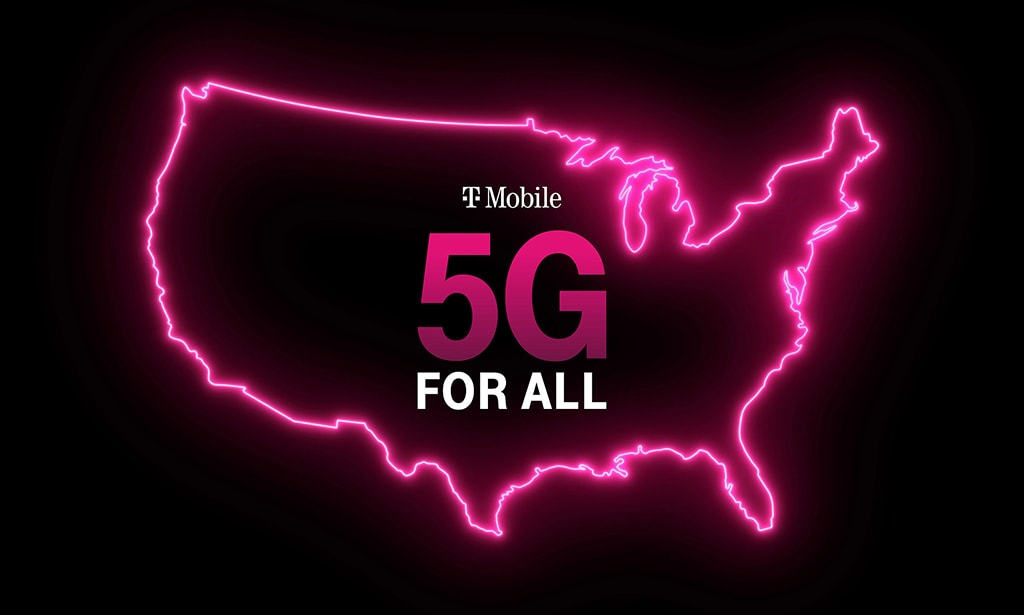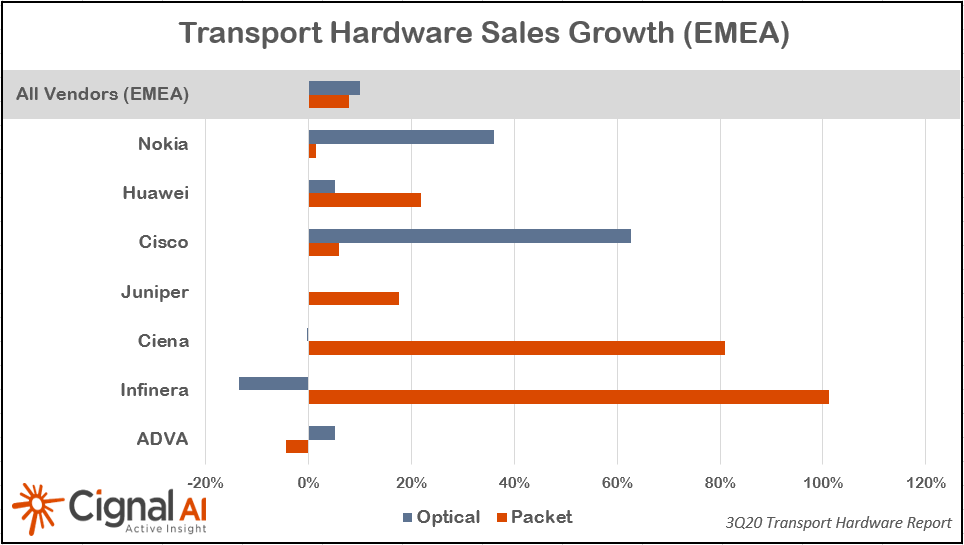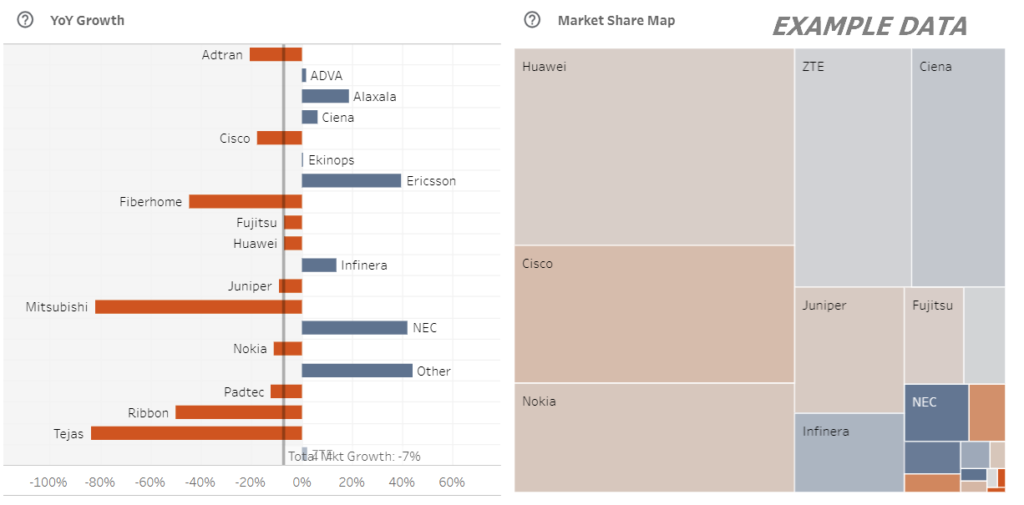Uncategorized
T-Mobile 5G hype vs Craig Moffett: “We’re not in the 5G era yet”
T-Mobile US reported total revenues of $19.8 billion and service revenues of $14.2 billion in the last quarter. T-Mobile’s gain of 1.2M post-paid net additions was solidly ahead of Wall Street consensus of 1.0M, and was similar to last year’s pro forma gain of 1.3M. The company added 773K post-paid phone subscribers, dramatically better than last year’s pro-forma gain of just 104K, and blowing away consensus of 475K.
T-Mobile’s 773,000 postpaid phone customer additions during the first quarter handily beat AT&T’s 536,000 and Verizon’s loss of 178,000 customers, according to Walter Piecyk, a financial analyst at LightShed Partners. They continue to take market share. Their annual post-paid subscriber growth rate of 3.9% marks a sharp acceleration from the 2.7% growth rate reported last quarter.
T-Mobile has already migrated 20% of Sprint’s customers, and 50% of Sprint’s traffic (a doubling from
last quarter), to the much more robust T-Mobile network. The vast majority of Sprint customers
are already enjoying service benefits from access (even with legacy handsets) to T-Mobile’s
lower frequency spectrum bands.
T-Mobile: America’s Largest, Fastest and Most Reliable 5G Network Extends its Lead
- Extended Range 5G covers 295 million people across 1.6 million square miles, 4x more than Verizon and 2x more than AT&T
- Ultra Capacity 5G covers 140 million people and on track to cover 200 million people nationwide by the end of 2021
- Majority of independent third-party network benchmarking reports show T-Mobile as the clear leader in 5G speed and availability
- Network perception catching up to reality with a nearly 120 percent increase in consumers who view T-Mobile as “The 5G Company” since Q3 2019

Image Credit: T-Mobile
……………………………………………………………………………………………………………………………………………….
On the company’s earnings call, T-Mobile US CEO Mike Sievert said that “discerning customers” are choosing T-Mobile’s new Magenta Max pricing plan, which offers few limits in the amount of 5G data that customers can consume. T-Mobile’s new Magenta Max customers consume 40% more data than its other 5G customers, and fully 70% more data than T-Mobile’s average 4G LTE customers.
“The take rate has just been amazing,” T-Mobile CFO Peter Osvaldik said of Magenta Max. “There are premium customers that are attracted to this premium network.”
“We’ve never been able to outrun the insatiable demand that customers have,” Sievert said of Internet service providers in general. “So when you provide the industry’s only true, unlimited plan, they do what they do, they use it up.”
According to Sievert, that indicates that T-Mobile’s 5G network will be a big winner. “We’re really starting to pull away from the pack. T-Mobile is positioned to maintain our 5G leadership for the duration of the 5G era.”
In a great example of braggadocio, Sievert said:
“We have again demonstrated that our unique winning formula and balanced approach enables us to grow share while delivering strong financial results. In our increasingly connected world, we recognize our role as stewards of this profitable company and industry, while continuing to use our Un-carrier DNA to bring change to wireless and broadband alike, to disrupt the status quo and ultimately benefit customers. And this quarter was no exception.”
T-Mobile said it now covers fully 140 million people with its 2.5GHz network, which it calls “ultra capacity.” By the end of this year, the company said that number will increase to 200 million people. Meantime, speeds available on that network will rise from an average of 300 Mbit/s today to up to 400 Mbit/s by the end of this year, the operator said. 5G speeds will continue to rise after that, according to T-Mobile’s network chief Neville Ray. “2022 is going to be even better,” he said.
Analyst Craig Moffett (who participated in the earnings call) put somewhat of a damper on all that 5G hype by stating: “But we’re not in the 5G era yet. We’re not even a year into the first generation of 5G iPhones. Less than 10% of Americans have 5G-enabled phones, and half of those probably only got a new phone because they needed a replacement. 5G isn’t really driving handset selection, or service provider selection, yet.”
“That T-Mobile continues to take share even in the twilight of the LTE era is reassuring. In a world of roughly comparable networks, they are competing on the basis of price alone… and they are taking share rapidly. In 5G, they will compete not only on the basis of the industry’s lowest prices, but also the industry’s best network. As we’ve said before, T-Mobile’s ‘worst to first’ story is a generational one. Networks don’t achieve advantage overnight, and they don’t lose it overnight, either. Ten and twenty-year cycles in telecom aren’t unusual.”
“T-Mobile’s brand, and its network, have been ascendant for years. But they have, up to now, achieved only parity. Their path to network superiority is potentially even longer, and, we suspect, even brighter.”
T-Mobile continues to increase market share even in the twilight of the LTE era is reassuring. In a
world of roughly comparable networks, they are competing on the basis of price alone… and they
are taking share rapidly. In 5G, they will compete not only on the basis of the industry’s lowest prices, but also the industry’s best network.
……………………………………………………………………………………………………………………………………….
References:
https://www.t-mobile.com/news/business/t-mobile-reports-strong-first-quarter-2021-results
https://www.lightreading.com/5g/does-5g-make-difference-t-mobile-says-yes/d/d-id/769256?
Verizon Explores Sale of Media Assets; Wake up Call for AT&T?
According to the Wall Street Journal, Verizon Communications is exploring a sale of its media assets including Yahoo and AOL, as the telecommunications giant looks to exit an expensive and unsuccessful bet on digital media. The sales process, which includes private-equity firm Apollo Global Management Inc. (which owns Cox Media Group) could lead to a deal worth $4 billion to $5 billion, according to people familiar with the matter—assuming there is one.
Verizon splashed out billions of dollars assembling a portfolio of once-dominant websites, including AOL and Yahoo. Verizon bought AOL in 2015, and Yahoo in 2017. It then merged them into a new venture called Oath, paying more than $9 billion in total to acquire the pair. So the rumored sale would be a huge loss for Verizon, based on what it paid for those two media outlets.
The digital-media business ultimately failed to reach its target of $10 billion in annual revenue by 2020, and Verizon in 2018 wrote down about $4.5 billion of its value. Verizon has cut jobs in the unit, and in November agreed to sell its HuffPost news division to BuzzFeed Inc. That followed a 2019 agreement to sell the Tumblr blogging platform for a nominal sum to the owner of WordPress.
Verizon’s media business, which also includes Yahoo Finance and Yahoo Mail (used by AT&T-Yahoo Internet subscribers) as well as news sites TechCrunch and Engadget, generated $7 billion of revenue in 2020, down 5.6% from the previous year due to a sharp advertising pullback during the early months of the coronavirus pandemic. Business picked up in the second half and the unit has logged two consecutive quarters of double-digit growth, including a boost of 10%, to $1.9 billion, in the first quarter.
…………………………………………………………………………………………………………………………………………
SIDEBAR — Message to AT&T:
If the Verizon media sales go through, it should send a clear message to AT&T, which went heavily into debt when it purchased Time Warner (and to a lesser extent DirecTV). AT&T has already spun off off its TV assets. AT&T agreed to create a new company for its U.S. video business unit together with private equity firm TPG Capital. The company will be called New DirecTV and include: today’s Direct TV, U-verse TV and AT&T TV (AT&T’s OTT video service). Closing the TV units “sale” will reduce their observed rate of decline. In the most recent quarter, video revenue shrank by 9.2%. That hemorrhage will stop once the video sale is complete. Next stop is for AT&T to sell or spin off Time Warner to reduce it’s debt load.
It’s incomprehensible to this author, that AT&T’s wireline Internet subscribers (actually AT&T-Yahoo Internet) are dependent on Yahoo support for email and any other content issues, including log-in. When you click on https://att.net you are redirected to https://currently.att.yahoo.com/. Since the 2017 Verizon acquisition of Yahoo, there is no tech support from AT&T on any email or content issues you might have with your AT&T-Yahoo internet account. AT&T will only troubleshoot wireline connectivity issues- NOT email or internet content problems its subscribers might experience.
……………………………………………………………………………………………………………………………………………..
By selling now, Verizon could raise needed cash at a time when valuations of similar assets are enjoying an upswing. The company this year committed about $53 billion to secure spectrum licenses that will support its ultrafast fifth-generation wireless network.
Indeed, Verizon was by far the biggest spender in January’s record-breaking FCC C-Band spectrum auction. The carrier bid nearly $45.5B, well ahead of still-heavy spending AT&T which paid $23.4B for that spectrum. Of course, there are huge additional build-out costs to actually deploy 5G over C-Band spectrum!
Verizon executives recently told investors that capital spending (CAPEX) this year on network equipment, fiber optic cables and the like could reach up to $21.5 billion.
Verizon has focused much of its recent attention lately on partnerships with streaming-video services like Disney+ and Hulu that can be bundled with its wireless and home-Internet plans.
Analyst Craig Moffett recently wrote in a note to clients:
“Verizon has, until now, taken a “wait-it-out” stance, perhaps out of confidence that AT&T’s (cellular network) promotional stance had to be transitory. Verizon’s short term results have suffered during this wait-it-out period; subscriber results have been weak.
Faced with AT&T’s ongoing retention marketing promotion, Verizon faces a lose-lose choice: either continue to lose subscribers (and face something still worse, when 5G comes around), or respond and their subscriber growth will recover, but their profitability will decline. There are no good options.
With longer term concerns about competitive positioning in 5G looming ever closer, we are
downgrading Verizon to Neutral.”
References:
https://www.wsj.com/articles/verizon-explores-sale-of-media-assets-11619642003
AT&T reports strong wireless growth in 1Q 2021; C Band ? Fiber footprint increases
AT&T reported strong wireless subscriber growth today. The company recorded $19.0 billion in mobility revenue, up 9.4% from a year earlier. While service revenue grew just 0.6%, with subscriber gains largely offset by continued pressure on international roaming amid the pandemic, AT&T’s equipment revenue rose 45.2% as AT&T benefited from a greater mix of higher priced smartphones. The latest results also benefitted from comparisons to those from a year-ago period that saw temporary store closures due to the beginning of the COVID-19 crisis.
The telecom/media recorded to 595,000 postpaid phone net additions for the quarter and a postpaid phone churn rate of 0.76%, which was down from 0.86% a year prior. Of the major wireless companies in the U.S., AT&T has been the most focused since the latest iPhone launch on offering promotions meant to drive upgrades from existing customers, rather than mostly targeting customers who would be switching from another carrier.
Impressively, AT&T added 235,000 AT&T Fiber customers in the 1st quarter of 2021, up from 209,000 in the year-ago period. Fiber penetration rose to 35% from 30% in Q1 2020.
During an earnings call, AT&T CEO John Stankey said the company added a total of more than 1 million fiber subscribers over the last four quarters, and was on track to build out fiber to 3 million consumer and business customer locations in 2021. He previously said AT&T was aiming to roll out fiber to 2 million new residential customers this year.
Reflecting on its progress thus far, Stankey said, “I like what I see in terms of our market position. If you look at things like lives, churn, customer satisfaction and net promoter scores and the actual performance of the product, they’re all great…I’ve not seen share movement on typical products like this as rapidly as we’re able to get share movement once we deploy an area.”
“We continued to excel in growing customer relationships in our market focus areas of mobility, fiber, and HBO Max,” said CEO John Stankey. “We had another strong quarter of postpaid phone net adds, higher gross adds, lower churn, and good growth in Mobility EBITDA.” AT&T posted 2.7 million total domestic HBO Max and HBO subscriber net adds, bringing total domestic subscribers to 44.2 million.
AT&T said it expects to spend $6 to $8 billion between 2022 and 2024 to deliver 5G services over its own midband C-band spectrum licenses. The company expects to cover up to 100 million people in “early” 2023, but that target generally trails the buildout plans of Verizon and T-Mobile.
“Global supply chains are stressed right now across the board. You ask the question, can you do the work? And people will give you comfortable answers,” Stankey said in response to questions about plans for C-band, timing and increased capex on AT&T’s first quarter earnings call.
“But I’m a little skittish,” Stankey acknowledged. “We’re seeing dynamics that are occurring in the global supply chain where unexpected things are popping up. And is it possible we could see certain element shortages that start to crop up as everybody’s racing to put stuff up on towers? It may.”
Stankey said that’s part of why he’s cautious about increasing guidance or making changes to C-band plans until there is a little momentum happening.
Likely as a result, Stankey expressed interest in purchasing additional midband spectrum licenses later this year during the FCC’s 3.45-3.55GHz spectrum auction. “I believe there could be an opportunity there,” he said.

Business Wireline, which accounts for 14% of AT&T’s consolidated revenues, saw weak results. This has historically been a highly cyclical business. Total Business Wireline revenue was $6.0B, down 3.5% YoY, a bit better than last quarter’s 4.1% decline. That result was considerably weaker than the expectation of a 3.5% decline.
As with peers, AT&T’s Business Wireline business has held up better than we would have expected during the COVID recession. Verizon noted last quarter that their own Business Wireline segment has been boosted by explosive growth in Public Sector revenues, driven in large measure by schools adjusting to the demands of remote learning, and they indicated that they expected some mean reversion. Perhaps, the CARES Act, which provides a huge amount of subsidy for schools and local governments, will soften (or even reverse) that blow.
AT&T Communications CEO Jeff McElfresh said that AT&T is “supportive” of President Joe Biden proposed infrastructure plan, which sets out to bring high-speed broadband to rural America, and that the company is “encouraging the government to do this in a smart way.” He argued that efforts to expand broadband access are “generally more impressive when you have scale backing the implementation” and that private-public partnerships, as well as collaboration within the telecommunications industry, can help drive success.
……………………………………………………………………………………………………………………………………….
Analyst Comments:
“AT&T appears to be ceding the field in wireless with a network plan that doesn’t even attempt to close the gap with T-Mobile and Verizon,” wrote the financial analysts at New Street Research in a note to clients released shortly after AT&T disclosed its first quarter financial results. “As with results today, for a little longer AT&T may be able to stem the tide of losses through continued aggressive promotions and retention offers, but this can only go so long given other costly priorities (a massive investment in HBO, a doubling of the fiber footprint) amidst generally constrained resources. Moreover, if they allow the network gap to widen too far, they may not be able to keep subs at any price (as was the case with Sprint in later years).”
“AT&T is investing in mobile and HBO Max, as it promised, and at great cost,” wrote the financial analysts at Sanford C. Bernstein & Co. in a note to investors. “The problem is, there are not enough investment dollars to go around. We believe the share price fairly reflects the highly uncertain outlook, and we are watching … as the competitive environment evolves.”
Craig Moffett of MoffetNatanson wrote: “The broadband business requires big capital investments up front for gradual and steady returns later… but the payback period even for good investments is as much as ten years…. The C-Band auction was just the beginning. Verizon has already committed to an additional $10B of capex over the next three years, and Verizon was, by all accounts, far ahead of AT&T already in small cell densification. And what of their costly handset giveaways? Can they be sustained?”
“The problem, as ever, is s AT&T’s debt load. To maintain any pretense that they will be able to pay down debt and service their $15B per year dividend, they need to sustain free cash flow at current levels, or grow it even. But service revenue is still declining, and, despite solid cost controls in Q1, EBITDA is still declining as well (down 4.7% YoY).”
…………………………………………………………………………………………………………………………………..
References:
Performance analysis of big 3 U.S. mobile operators; 5G is disappointing customers
Speedtest Intelligence® from Ookla reveals T-Mobile was the fastest mobile operator in the United States during Q1 2021 with a Speed Score™ of 50.21 on modern chipsets. AT&T was second and Verizon Wireless third.
Note that this is the first quarter Ookla is reporting on the country as a whole, rather than using competitive geographies. Ookla says that expanding its focus to include rural areas will show drops in performance, decreasing speed and increasing latency when compared with prior reports.
In Q1 2021, T-Mobile had the fastest median 5G network download speed in the U.S. at 82.35 Mbps. AT&T was second at 76.60 Mbps and Verizon Wireless third at 67.24 Mbps. For a complete view of commercially available 5G deployments in the U.S. to-date, visit the Ookla 5G Map™.
Ookla discovered that during Q1 2021 that T-Mobile subscribers with 5G-capable devices were connected to a 5G service 65.4% of the time. 5G “time spent” on Verizon Wireless’ network was at 36.2% and at 31% on AT&T’s network.
In measuring each operator’s ability to provide consistent speeds, Ookla found that T-Mobile had the highest Consistency Score™ in the U.S. during Q1 2021, with 84.8% of results showing at least 5 Mbps download and 1 Mbps upload speeds. AT&T was second and Verizon Wireless third. All three U.S. mobile carriers were above 80% in terms of consistency.
Here’s the current status of Worldwide median 5G Speeds as of Q3-2022:

…………………………………………………………………………………………………………………………………..
Earlier this week a new report from becnhmarking company Rootmetrics found that T-Mobile US is leading in 5G availability across U.S. cities. Rootmetrics found that AT&T’s 5G provides the best performance, and AT&T and Verizon both won high marks for 5G reliability.
“While we’ve seen strong and improving 5G availability and speeds from the carriers in many cities, it’s important to keep in mind that with the major U.S. networks utilizing different types of spectrum for 5G, the 5G availability and speeds that consumers experience can vary a great deal for different carriers across or even within different markets,” Rootmetrics concluded.
Rootmetrics tested 5G networks in 45 cities across the U.S. between January and March of this year. It recorded at least some 5G availability from all three carriers in nearly all of them. T-Mobile US was the only carrier with a 5G network presence in all 45 of the cities, AT&T had 5G service in 44 out of the 45, and Rootmetrics saw 5G availability for Verizon in 43 out of the 45 cities.
The availability of T-Mobile’s 5G was one common theme across both testing reports. Rootmetrics’ testing, conducted in the first half of 2021, said that T-Mobile had 5G availability in all 45 of the markets it tested and showed the highest percentages of 5G availability in the most markets: More than 55% availability in 30 markets, with the lowest tested market being Sarasota, FL, where Rootmetrics’ testing showed T-Mo 5G available for a device to connect to only about 19% of the time.
…………………………………………………………………………………………………………………………………………
Separately, Light Reading’s Mike Dano writes that “AT&T, Verizon and T-Mobile offer unlimited 5G disappointment.” In a subhead titled, “T-Muddle” Dano writes:
In 2019, T-Mobile boasted that “5G speed will be up to 10x faster, compared to LTE.” But when it first launched its 5G network on its lowband 600MHz spectrum, speeds were only 20% faster than its LTE network. Then, after T-Mobile closed its acquisition of Sprint’s 2.5GHz midband spectrum, it quickly began offering 5G speeds up to 1Gbit/s. The operator even debuted a new 5G lexicon for its offerings: “5G Ultra Capacity” refers to its speedy 2.5GHz network, while “Extended Range 5G” refers to its slower 600MHz network.
So it would stand to reason that customers might want to see which flavor of T-Mobile 5G they can access, right? A quick check of T-Mobile’s coverage map reveals none of these details. The operator only offers a generic “5G” coverage layer that does not provide details about whether it’s 600MHz or 2.5GHz. One is slightly faster than LTE while the other provides average speeds of 300Mbit/s. Prospective T-Mobile customers are left in the dark.
T-Mobile isn’t the only operator seemingly content to hide behind 5G obfuscation. AT&T has debuted no fewer than three different 5G brands – 5G+, 5Ge and 5G – yet it does not offer any details to prospective customers about how it might charge for those offerings. The operator’s pricing plans mention only “5G” and do not specify whether that means 5G+, 5Ge or 5G, or all three.
Regarding Verizon’s 5G pricing plans, Dano stated:
The operator offers a truly dizzying array of 5G plans and pricing options – one observer described Verizon’s pricing plans as “a series of nesting dolls.”
In 5G, Verizon is reserving its faster “Ultra Wideband” technology only for its expensive unlimited plans. Customers on its cheapest Start Unlimited plan can either pay $10 extra for 5G specifically, or they can spend that same $10 to upgrade to a more expensive unlimited plan that offers 5G as well as other goodies, such as more mobile hotspot data. Why the two different upgrade options? “We always like to give customers choices,” explained a Verizon spokesperson.
But what that really means is that customers are simply left to fend for themselves. They’re left to pick from among a dizzying number of pricing options, all promising “unlimited” data, but all limiting that data in various ways. Customers are left to figure out why messages from iPhones to Android phones won’t show delivery receipts. They’re left to discover why they’re still receiving robocalls, and what they might need to do to block them. They’re left to uncover what kind of 5G they can get and whether it’s any different from 4G.
In conclusion, Dano says that “AT&T, Verizon and T-Mobile continue to be very interested in outdoing one another in their 5G pricing schemes and big, new network claims.” However, they’re not succeeding in pleasing their customers who remain frustrated and disappointed.
Cartoon courtesy of long time IEEE contributor Geoff Thompson:
…………………………………………………………………………………………………………………………………………
References:
https://www.speedtest.net/global-index/united-states#market-analysis
https://rootmetrics.com/en-US/content/5g-in-the-us-1H-2021
Starlink now covers all of UK; Plans to connect vehicles with satellite Internet service
Starlink has expanded to all regions of the United Kingdom. The SpaceX owned company’s satellite Internet service is still in beta and was previously available in only the southern England part of the UK. Today, the company announced an expansion to cover parts of Wales, Scotland, Northern Ireland, and northern England. Starlink says users should currently expect data speeds to vary between 50Mb/s to 150Mb/s over the next several months, with brief periods of no connectivity whatsoever.
Starlink’s Email:
Starlink is now available in parts of Wales, Scotland, Northern Ireland and northern England, in addition to existing service areas in southern England.
During beta, users can expect to see data speeds vary from 50Mb/s to 150Mb/s over the next several months as we enhance the Starlink system. There will also be brief periods of no connectivity at all.
As we launch more satellites, install more ground stations and improve our networking software, data speed, latency and uptime will improve dramatically.
To check availability for your location, visit starlink.com and re-enter your service address. If Starlink is not yet available in your area, you can place a deposit to hold your space in line for future service.
The UK’s average download speed across all broadband providers is around 67.23Mb/s, but climbing as the rollout of full-fiber starts picking up pace again following a pandemic-induced slowdown.
Starlink wants to quickly deliver decent broadband connectivity to rural locations which have been left underserved due to the difficulties and cost of laying traditional fiber.
“This will transform rural WiFi,” says Compare Fibre’s co-founder Nathan Hill-Haimes. “We are really keen to stress the impact this can have on connecting rural locations with high-speed internet.”
A Starlink user from Devon told the Press Association: “If you need connectivity to run a business and if you need connectivity for communication, particularly in Covid times, £90 a month is quite justifiable.”

Starlink was issued a UK “Earth station network license” in November, an Ofcom spokesperson told CNBC. The £200 ($272) a year license allows Starlink to sell satellite dishes and other communications equipment in the U.K. so that people can pick up signals emitted by Starlink’s network of satellites.
………………………………………………………………………………………………………………………………………
Separately, SpaceX wants to begin connecting large vehicles – from trucks to jets to ships – to its Starlink satellite Internet network, according to a request the company filed with the Federal Communications Commission (FCC).
“This application would serve the public interest by authorizing a new class of ground-based components for SpaceX’s satellite system that will expand the range of broadband capabilities available to moving vehicles throughout the United States and to moving vessels and aircraft worldwide,” SpaceX director of satellite policy David Goldman wrote in a letter to the FCC filed on Friday.
Starlink is the company’s capital-intensive project to build an interconnected internet network with thousands of satellites, known in the space industry as a constellation, designed to deliver high-speed internet to consumers anywhere on the planet.
To date SpaceX has launched more than 1,100 satellites for Starlink. In October, SpaceX began rolling out early service in a public beta to customers in the U.S., Canada and the U.K., with service priced at $99 a month. Additionally, in a late January update, SpaceX told the FCC that its Starlink beta now has more than 10,000 users.
The Starlink service also includes a $499 upfront cost for the hardware needed to connect to the network. Known as the Starlink Kit, it includes a user terminal (the small, dish-like antenna) and a Wi-Fi router.
SpaceX did not indicate in its filing Friday whether the Starlink user terminals for moving vehicles will have a different design than the dishes currently being shipped to early customers. But SpaceX said each “ESIM,” or Earth Station In Motion, is “electrically identical to its previously authorized consumer user terminals,” with added “mountings that allow them to be installed on vehicles, vessels and aircraft.”
The company also noted that it “will ensure installation” of the vehicle terminals through “qualified installers.” While SpaceX did not say whether those installers would be company employees, it continues to expand Starlink manufacturing and operations – including plans for a new equipment factory in Austin, Texas.
Over 1,000 Starlink satellites are currently in orbit of the total 12,000 satellites which have been authorized. Filings have been submitted to the International Telecommunication Union (ITU) requesting permission to launch 30,000 additional Starlink satellites.
Increasing competition:
Starlink is, by far, the biggest satellite broadband deployment. However, rivals such as Amazon’s “Project Kuiper” will be looking to challenge the titleholder in the coming years.
Project Kuiper was given the green light by the FCC last year to launch 3,236 of its own satellites.
“We are doing an incredible amount of invention to deliver fast, reliable broadband at a price that makes sense for customers,” Rajeev Badyal, Vice President of Technology for Project Kuiper, said at the time.
SpaceX is currently launching around 60 satellites at a time and aims to have deployed 1,440 by late 2021 to provide near-global service.
“As we launch more satellites, install more ground stations and improve our networking software, data speed, latency and uptime will improve dramatically,” the company wrote in a release announcing Starlink’s expansion in the UK.
Starlink and Kuiper will also be competing against promising satellite broadband firm OneWeb.
OneWeb nearly collapsed after crucial funding was pulled last-minute during the first peak of the COVID-19 pandemic and filed Chapter 11 bankruptcy. However, the company was rescued following a $1bn (£800m) investment from the UK government and Bharti Global Ltd of India.
Kwasi Kwarteng, Secretary of State for Business, Energy, and Industrial Strategy, said: “Our investment in OneWeb is part of our continued commitment to the UK’s space sector, putting Britain at the forefront of the latest technological advances.”
Since the UK and Bharti’s investment, OneWeb has continued to receive large investments. In January, the company announced that it has raised $1.4 billion in total funding after securing investments from SoftBank Group and Hughes Network Systems.
Masayoshi Son, Chairman and CEO of SoftBank, commented: “We are excited to support OneWeb as it increases capacity and accelerates towards commercialization. We are thrilled to continue our partnership with Bharti, the UK government, and Hughes to help OneWeb deliver on its mission to transform internet access around the world.”
OneWeb is the smallest of the three satellite broadband firms but has launched 74 of its innovative ultrafast broadband satellites to date and plans to launch a total of 648 by the end of 2021.
Neil Masterson, CEO of OneWeb, said: “OneWeb’s mission is to connect everyone, everywhere. We have made rapid progress to re-start the business since emerging from Chapter 11 in November.”
……………………………………………………………………………………………………………………………..
References:
Assessment of COVID-19 impact on telecom industry; C-Band Spectrum Update
COVID-19 Impact on Telcos:
Source: Analysys Mason

The telecommunications industry has suffered limited damage as a result of the COVID-19 pandemic. Revenue figures for most network operators have fallen slightly, but few have encountered anything that is particularly severe or long-lasting. As a result, few telcos have made significant changes to their strategy.
However, some aspects of the telecoms sector have been significantly affected by the pandemic. The most obvious is business services; revenue in this segment declined sharply for most operators in 2020 and prospects for 2021 are uncertain. Operators may have to rethink important parts of their strategies related to these aspects.
The telecoms industry has been affected by the pandemic in many different ways, and have been grouped these into three main categories depicted in the figure below:
Summary of the impact of the COVID-19 pandemic on the telecoms industry

Assumptions of a stable economy and a continuation of existing service and technology trends often underpin an operator’s strategic plan. For some of the services offered by operators, business services in particular, these assumptions look outdated and may need a rethink.
………………………………………………………………………………………………………………………………………………………………………………………..
C-Band Auction Update:
Source: MoffettNathanson Research
Heading into the FCC’s C-Band auction, Wall Street analysts saw Verizon as the leading bidder for 5G wireless radio spectrum. Bidding for licensed spectrum in the telecom industry’s most expensive auction ever reached more than $75 billion on Monday amid speculation over how much each of the big wireless telcos and cable companies have paid.
In a note to clients, analyst/colleague Craig Moffett of MoffettNathanson is assuming that Verizon will end up being the largest buyer at the ongoing auction of mid-band spectrum targeted for new 5G deployments. As a result, Verizon’s balance sheet will be more heavily burdened and more of their future cash flows will be diverted to debt service so their future profits will be lower.
AT&T, on the other hand, will “be disadvantaged for a generation” if they don’t get a significant chunk of the mid-band spectrum being auctioned. Craig believes that AT&T was probably “one of the two big bidders that more or less backed away after round 24 or round 38.”
An important issue is “whether “winners” in this auction acquired reasonably uniform contiguous blocks, or whether they instead (worst case scenario) ended up with a patchwork of licenses and a hefty bill to burden the balance sheet. If so, will their footprints be largely erased by subsequent topping bids from others.”
With respect to using the purchased mid-band spectrum for accelerated 5G deployments, Craig wrote: “At best, the huge sums paid here for spectrum risk displacing the capital investment needed to put the acquired spectrum to use. At worst, they risk financially destabilizing one or more players.”
In conclusion, Craig asks if the large amounts of money being spent for an asset (licensed mid-band spectrum) that is best thought of as simply maintaining the status quo will be worth the price paid? “Again, the most important question is this: is anyone going to change their revenue forecast just because the industry had to spend twice as much as expected to buy spectrum for 5G.”
………………………………………………………………………………………………………………………………………………………………………………………
References:
Mid-band Spectrum for 5G: FCC C-Band Auction at $70B Shattering Records
Deutsche Telekom Progress Report on 5G and FTTH
Deutsche Telekom (DT) is rounding out 2020 with an upbeat announcement on its achievements and ambitions in 5G and FTTH. The largest telco in Germany highlighted progress in the rollout of 5G and uptake of the technology in its home market. Two-thirds of the population can use 5G, which was its target figure for the end of year, as outlined in the summer, with 45,000 5G-capable antennas deployed.
Two thirds of people in Germany can now use 5G on the Telekom network. 45,000 antennas are already transmitting on 5G. Here too, Deutsche Telekom intends to continue expanding rapidly. In the coming year, the 80 percent mark for population coverage is to be reached with 5G. By 2025, it should be 99 percent – as announced.
“Never before have we been able to set up a new network technology faster than now with 5G. The fact that just over a year after the frequency auction, two-thirds of the population can already use 5G is the fastest expansion in the history of mobile communications. Telekom is the 5G engine in Germany. And 2020 was clearly the 5G year,” said DT CEO
With 5G, Deutsche Telekom is combining expansionan. in two frequency bands. On the high-reach 2.1 GHz frequency, high mobile bandwidths will be brought to rural areas in particular. For example, the offshore island of Helgoland is now also being supplied with 5G. The 3.6 GHz frequency provides high-speed 5G where many people move around in a small area, such as in large cities. It is now also used at Frankfurt Airport. The technology will also be installed at Berlin’s BER airport. New are also the 5G Highspeed antennas in Bremen, Hanover and Nuremberg. This means that 13 major cities are already benefiting from 5G in gigabit speed.
“Telekom keeps its promises. This applies in particular to network expansion. Right now, the Telekom network is proving its worth. It was the right decision to put fiber optic in every street and thus to enable fast networks from Telekom for over 80 percent of all households. Home offices are possible throughout the country. Now comes the next step: Fiber optic to the home and 5G. Here too, we have a plan that we are working through step by step. Despite Corona, our expansion is running at full speed,” says Deutsche Telekom CEO Tim Höttges. “And to make sure that everyone in Germany is part of it in the future, we are now really getting going. To achieve this, we have been investing around five and a half billion euros a year in Germany for years. Most of it will go into our network.”
The telco also revealed that every other contract or contract extension it sells now includes a 5G device, a figure that suggests users are starting to embrace the technology.
“2020 was clearly the 5G year,” said Srini Gopalan, who took over as head of Deutsche Telekom in Germany just over a month ago. Coverage of two-thirds of the population is certainly a significant milestone.
“We are building for digitization in Germany. The better the framework conditions for investment, the smoother the fiber-optic expansion will run. New technology and new times also require new and flexible answers,” says Tim Höttges. “What additionally helps us with the expansion are, for example, quick approvals. On the other hand, the acceptance of alternative laying methods beyond civil engineering would simplify and accelerate many things. But it also requires a clear commitment from the competition to FTTH. This is a task for society as a whole that we must tackle together. We too have learned our lesson and are focusing much more strongly on cooperation, especially with local suppliers.”
Deutsche Telekom has rolled out FTTH to around 2 million households in Germany, having added somewhere between half a million and 600,000 in 2020: its description of the number of households added varied in the announcement. Last year it rolled out full fiber to 270,000 homes. Going forward, DT is shooting for 2 million homes added per year.
“FTTH is the key to the next surge in digitization. We have revolutionized our processes to achieve this,” says Srini Gopalan, member of the Deutsche Telekom Board of Management responsible for Germany. “Our Fiber Factory is now really taking off. This means we are bringing the fiber directly to where it will be needed more and more in the future: In households, businesses and schools. In the city and in the country.”
References:
ITU Virtual Digital World SME Awards for Connectivity, Smart Cities, e-Health, Digital Finance
- Connectivity – new approaches to increasing universal access to the internet
- Smart cities, smart living – improving urban life in areas such as energy, transport, planning, education
- E-health – improve healthcare through remote diagnosis and treatment
- Digital finance – increase access to the digital economy for the banked and unbanked
From very small satellite-powered remote IoT sensors to mobile finance for smallholder farmers, navigational platforms for smart public transit or portable electrocardiograms for remote diagnosis and much, much more, this virtual edition of the ITU Digital World Awards – open to all small- and medium-sized enterprises (SMEs) worldwide – celebrated creativity and innovation in digital solutions meeting real-world needs.
- Astrome from India, using millimetre wave wireless communication to provide fibre-like backhaul capacity for 4G and 5G infrastructure, in the Connectivity category;
- BusMap from Viet Nam, providing smart public transit solutions through navigation algorithms and advanced user experience features for consumers, corporates and governments in the Smart cities, smart living category;
- Appy Saude from Angola, for their e-health platform identifying the nearest pharmacy location, best price and availability of medicines, in the E-health category;
- OKO Finance from Israel, providing smallholder farmers with crop insurance and access to digital financial tools through simple mobile technologies, in the Digital finance category.


Millimeter Wave Market Projected to reach 7.38B by 2027; 37% CAGR
The global telecom millimeter wave technology market size is projected to reach USD 7.38 billion by 2027, registering a CAGR of 37.01%.
Millimeter Waves (MMW) can transmit a large amount of data efficiently, operating in the electromagnetic spectrum of 30 GHz to 300 GHz. Millimeter waves are also known as Extremely High-Frequency (EHF) waves owing to its operational frequency spectrum. The property of transmitting a large amount of data has made the technology popular across the telecommunication application.
The MMW technology industry is prominently dependent on the applications in various verticals where it is used extensively. Major application areas include telecommunication, military and defense, security services, and medical and healthcare. Evolution of 5G technology is likely to occur over the coming years on account of recent developments and continuous research and progress in the telecom industry.
Millimeter waves are anticipated to play a vital role in the development of 5G technology on account of the technology’s demand for higher-bandwidth. The 5G technology is predicted to emerge in the coming years and the market is likely to witness its adoption significantly. Eventually, the demand for MMW technology is expected to boost, in turn, propelling the overall MMW technology market, particularly across the telecom industry.
Increased government funding and initiatives coupled with intensive R&D carried out from the military and private sectors are leading towards the improvement of the MMW technology. In addition, the E-band frequency segment having extensive application in the telecommunication sector is estimated to generate the highest revenue. The E-band frequency segment is projected to keep on dominating in the telecom industry owing to the growing telecom applications. Therefore, the overall telecom millimeter wave technology market is poised to witness significant growth worldwide over the forecast period at a notable pace.
Telecom Millimeter Wave Technology Market Report Highlights:
- North America accounted for the largest market share in the telecom MMW technology market owing to the technology’s early and greater adoption rate
- U.S. being the highest revenue generating country in 2019 in North America, the regional market is predicted to exhibit steady growth over the forecast period
- E-band frequency segment is anticipated to grow rapidly over the estimated duration owing to its extensive adoption in the telecom applications
- The telecom industry in the Asia Pacific is poised to expand substantially over the coming years, and the E-band frequency segment is likely to witness lucrative opportunity in the regional telecom industry
- Besides, growing urbanization in the Asia Pacific region and competition amongst the telecom service providers to offer superior quality of internet and other related services in order to enlarge customer base is another factor expected to drive the telecom MMW technology market
- Online streaming of high-quality videos, online gaming, and other entertainment stuff which demand high bandwidth and consume heavy data are again likely to fuel the overall demand for MMW technology in the telecom sector globally.
Millimeter wave (mmWave) communication systems have attracted significant interest regarding meeting the capacity requirements of the future 5G network. The mmWave systems have frequency ranges in between 30 and 300 GHz where a total of around 250 GHz bandwidths are available. Although the available bandwidth of mmWave frequencies is promising, the propagation characteristics are significantly different from microwave frequency bands in terms of path loss, diffraction and blockage, rain attenuation, atmospheric absorption, and foliage loss behaviors. In general, the overall loss of mmWave systems is significantly larger than that of microwave systems for a point-to-point link.
Fortunately, the small wavelengths of mmWave frequencies enable large numbers of antenna elements to be deployed in the same form factor thereby providing high spatial processing gains that can theoretically compensate for at least the isotropic path loss. Nevertheless, as mmWave systems are equipped with several antennas, a number of computation and implementation challenges arise to maintain the anticipated performance gain of mmWave systems. Toward this end, this chapter discusses key enabling techniques of the mmWave based 5G network from the link level perspective. The link level performance of the mmWave wireless system depends on a number of factors, including the transmission scheme (i.e., whether we employ beamforming, multiplexing, or both), the approach to identifying the channel, how to design the transmitted signal waveform structure and access strategies.
References:
https://www.sciencedirect.com/topics/engineering/millimeter-wave
Dell’Oro and Cignal AI: Optical Transport Equipment Market Grows in 3Q 2020
According to a recently published report from Dell’Oro Group, the optical transport equipment revenue increased 9 percent year-over-year in 3Q 2020 reaching $3.8 billion. The market growth was largely attributed to higher demand in Asia Pacific.
“Sales slowed in North America following a strong first half of the year,” said Jimmy Yu, Vice President at Dell’Oro Group. “Whether it was due to network demand caused by people working and studying from home or new projects at the beginning of the year, the demand for optical equipment in the region rose 11 percent in the first half of 2020. But I think there was enough concern surrounding the longevity of the pandemic that service providers grew cautious and refrained from overextending their capital. As a result, optical revenue in North America declined 7 percent in the third quarter,” continued Yu.
Growth in Asia Pacific more than offset the lower revenue in North America and Latin America. Optical revenue grew 22 percent year-over-year in Asia Pacific, driven largely by higher deployments in China and Japan. Also, with lockdown restrictions easing, some regions such as Middle East and Africa (MEA), significantly rebounded in the quarter following a sharp decline in 1H 2020. Sales in China, Japan, and MEA each grew over 25 percent.
The Dell’Oro Group Optical Transport Quarterly Report offers complete, in-depth coverage of the market with tables covering manufacturers’ revenue, average selling prices, unit shipments (by speed including 100 Gbps, 200 Gbps, 400 Gbps, and 800 Gbps). The report tracks DWDM long haul, WDM metro, multiservice multiplexers (SONET/SDH), optical switch, optical packet platforms, data center interconnect (metro and long haul), and disaggregated WDM. To purchase this report, please contact us at [email protected].
Dell’Oro Group is a market research firm that specializes in strategic competitive analysis in the telecommunications, networks, and data center IT markets. Our firm provides in-depth quantitative data and qualitative analysis to facilitate critical, fact-based business decisions. For more information, contact Dell’Oro Group at +1.650.622.9400 or visit https://www.delloro.com
…………………………………………………………………………………………………………………………………………………………………………………………………………..
|
|||
 |
|||
|
|||
 |
|||
About the Transport Hardware Report
About Cignal AI
|




